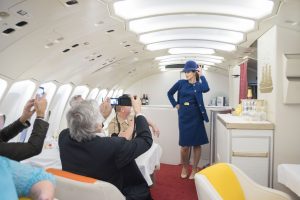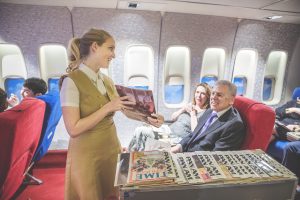IBM Industries Blog — What today’s airlines can learn from the ‘golden age’ of flying

Vibe Agency
March 20, 2018Exciting news, everyone! The Pan Am Experience is relocating to a new, even more fantastic location! Stay tuned…
July 7, 2023What today’s airlines can learn from the ‘golden age’ of flying
March 27, 2018
By Jordan Teicher
Original Story
Several times a month, a few dozen people dressed to impress board a Boeing 747 in Los Angeles, where they’re met with a smile and the cocktail of their choosing. They then sit back in a plush Sleeperette seat, and spend the evening socializing with fellow passengers, enjoying an open bar, and eating a five-course meal that includes a Chateaubriand carved from a trolley.
It would be the perfect flight, if only it were on a real plane.
Passengers on this “flight,” known as the Pan Am Experience, never get off the ground. Instead, they sit in a Boeing 747 replica parked in a Southern California aviation-themed motion picture studio called Air Hollywood. Their time on board is designed to recreate the experience of a flight with the now-defunct Pan Am airline during the late 1960s and early 70s. Tickets, which cost $300, typically sell out within a few minutes after they’re made available.
“We’ve had people walk on to our airplane and start crying because it reminded them of the old days and the good time they had,” Talaat Captan, CEO & Founder of Air Hollywood, told IBM.

In an age of shrinking legroom, diminishing onboard service, and increasing hidden charges it’s no wonder that nostalgia for the so-called “golden age” of air travel is so strong, said IBM Travel and Transportation Industry VP Rob Ranieri.
“I think the way we used to fly was more of a luxury event. In the old days, you’d pay a single price for a full service flight. You were really taken care of,” Ranieri said.
A changing industry
To a certain extent, Ranieri said, there’s no going back to the golden age. Deregulation and the growth of low-cost carriers has fundamentally changed industry dynamics. Airlines, he said, have economized in an effort to get passengers from A to B at the cheapest possible cost. That means more seats on board, less legroom, a smaller flight crew, and fewer built-in amenities.
Security protocols have also irrevocably changed. Even if there were extra room on board for communal bars and lounges today, Ranieri said, post-9/11 safety concerns would keep passengers in their seats rather than roaming freely about the cabin. For practical reasons, flights simply can’t be as social as they were in the 70s.

The golden age, of course, wasn’t all roses. Flights were so expensive that most people could only fly a handful of times a year. Planes were louder. There were fewer routes. And cabins were full of cigarette smoke.
But today’s common passenger complaints are valid, Ranieri said, and they can’t be ignored. If airlines want to stay in business, they must figure out how to improve the customer experience within the regulatory and economic constraints of the day.
Modernize and optimize travel efficiently
“Passengers want the best value for their money, but on the other hand they want to enjoy traveling,” Ranieri said.
Prioritizing personalization
Finding that balance is tricky, said IBM Global Travel & Transportation Industries Executive Partner Heidi Fillmore, but it’s possible. With the right technological tools, she said, airlines can make passengers can feel as personally cared for as they did in the 70s while keeping costs down.
At the gate, Fillmore said, agents with better access to customer data can be empowered to make smart decisions that earn customer loyalty. Currently, she said, most ticket agents are only able to access limited information on passengers, including their seat and meal preference, and the number of trips they’ve taken with the airline previously.
“But when you start to layer in all the other elements beyond what’s just sitting in your loyalty database—things like, ‘We lost your bag last time,’ or, ‘Your flight was delayed last time, or the last three times’—this is now a point where you have the opportunity to do something about that,” Fillmore said. “It’s about having a richer set of information at your fingertips so you have the opportunity to provide some better service or perks.”
On board, flight attendants armed with a similarly robust set of data could be more efficient and more attentive. Having access to each passenger’s preferences on an iPad, for instance, can help a single flight attendant provide more personal service to more people. American Airlines became the first airline to equip all its flight attendants with tablets in 2012.
“Equipping crew members with digital devices gives them access to information that allows them to address passengers in a relevant way,” Raymond Kollau, founder of airlinetrends.com, told Fortune. “It’s also a way to increase inflight revenues, as the transaction process is quicker.”
In the event of a flight cancellation, Fillmore said, airlines could use AI to quickly find a passenger’s next best travel option. Airlines could also use AI on their websites to provide personalized recommendations based on both structured and unstructured data for passengers booking flights and accommodations.

The allure of the golden age of travel encapsulated in the Pan Am Experience will likely not lose its appeal any time soon. But airlines in 2018 can’t parrot the past, and luckily they don’t need to in order to provide an excellent experience for passengers. The golden age glistened, in part, because it strove to provide the same elevated experience for all passengers. Today, with cutting edge technology, airlines can instead provide a unique experience for each passenger, one that considers their unique tastes and desires.
“The reality is not everyone wants a meal and drinks and everything that came with the old way of flying,” Ranieri said. “The way to do this cost effectively is to cater more personally to each individual.”
The travel and transportation industry is growing, and expectations are rising from today’s savvier, more connected travelers. Discover how IBM can help you deliver personalized travel experiences, drive revenue lift and improve distribution agility.
Jordan Teicher
Content Producer, IBM Industries

